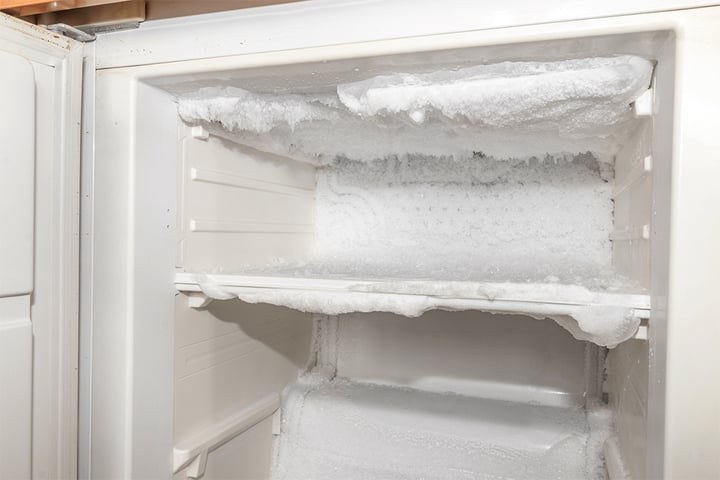
Why Does Your Refrigerator Frost Over and Does It Increase Electricity Consumption?

Many people notice frost building up in their refrigerator over time, especially in the freezer compartment. This raises a common question: Does a frosty fridge consume more electricity? The answer is yes, and the effect can be significant if the issue isn’t addressed promptly. Frost not only reduces storage space but also impacts the fridge’s efficiency and energy usage.
Why Does a Refrigerator Frost Over?
Frost formation is common in older refrigerator models or units without an automatic defrost (No Frost) feature. When humid air enters the freezer, the water vapor condenses and freezes on cold surfaces, forming thin layers of ice. Over time, these layers thicken and may cover the freezer walls, ice trays, or even the cooling pipes.
Common causes include:
-
Leaky fridge door: If the seal isn’t tight, humid air continuously enters.
-
Frequent door opening: Constant exposure to warm, moist air accelerates frost buildup.
-
Placing hot food directly inside: The heat releases steam, which condenses and freezes.
-
Lack of regular defrosting: Without periodic ice removal, frost accumulates progressively.
Does Frost Increase Electricity Consumption?
Yes, frost can significantly increase a fridge’s electricity usage. Here’s why:
-
Frost acts as an insulator: Even a thin layer of ice reduces heat transfer between the cooling elements and the air inside. As a result, the fridge must work harder and longer to maintain the desired temperature.
-
Compressor works harder: When frost accumulation lowers cooling efficiency, the compressor runs more frequently and for longer periods, consuming more energy.
-
Studies indicate that a frost layer about 5 mm thick can increase energy consumption by 10–15%.
-
If frost exceeds 1 cm, electricity use can rise by 30% or more, depending on the fridge model and usage.
-
Reduced storage space and airflow: Frost takes up room in the freezer, often leading users to overcrowd food items. This obstructs cold air circulation, causing uneven cooling and forcing the fridge to work harder to maintain consistent temperatures.
Other Effects of Frost Buildup
Frost isn’t just an energy issue—it can affect your fridge’s performance and lifespan:
-
Food quality is compromised: Poor airflow can create warmer spots, making food spoil faster.
-
Cleaning and maintenance become harder: Thick frost layers are difficult to remove and can trap dirt.
-
Potential component damage: Frost may interfere with temperature sensors or fans, reducing the fridge’s efficiency and longevity.
Tips to Reduce Frost and Save Energy
You can minimize frost buildup and improve efficiency by following these tips:
-
Choose a No Frost refrigerator: These models circulate air with a fan and automatically defrost periodically, preventing frost accumulation.
-
Defrost regularly: For conventional fridges, remove ice every 2–3 weeks to maintain performance.
-
Ensure a proper seal: Check rubber gaskets on doors to ensure they are airtight. Avoid leaving the door open too long.
-
Avoid putting hot food inside: Let food cool to room temperature before storing to reduce condensation.
-
Don’t overcrowd the fridge: Leave space between items for proper airflow, ensuring consistent cooling and reducing the compressor workload.
Conclusion
Frost may seem harmless, but it quietly increases electricity bills and reduces fridge efficiency. By choosing the right model, using it correctly, and performing regular maintenance, you can prevent frost buildup, save energy, and prolong the life of your refrigerator—all while keeping your food fresh and your electricity costs lower.
News in the same category


Had no clue about this

How to Grow Potatoes Easily from Sprouted Tubers and Enjoy Them All Year Round

You are doing it all wrong. Here’s the right way to ease morning stiffness

You are doing it all wrong. Here’s the right way to clear sinus pressure fast

Doctors Warn: 4 Types of Inflammation That Can Turn Into Cancer Within a Year If Left Untreated

**Garlic Skins Are Not Trash — Don’t Throw Them Away Yet!

There are too many geckos in the house, give you some tips to make them 'once gone and never come back'

When cleaning the house, add this to the water and the floor will be as clean as new

How to boil chicken until it's soft and sweet

Washing your hair with rice water helps your hair get rid of dandruff

Experience growing tomatoes in fruitful pots

My nana taught me this hack to strengthen thinning hair in 7 mins with 0 work. Here’s how it works

You cook all day but you probably don't know these 3 ways to cook rice.

Toilet lid and seat are yellowed for a long time: Apply this tip to make the toilet white and free of bad odors

Soak garlic in dishwashing liquid: 'Miracle water' solves many household problems that very few people know about

3 ways to wash fans without removing the fan cage: Women can do it well too

How to grow bitter melon to produce fruit and provide shade in your home garden

10 Effective Ways to Reduce Dust in Your Home – Keep Your Living Space Clean and Healthy
News Post

DIY Vaseline Cream: The 4-Ingredient Glow Hack That Makes Your Skin Baby-Soft Overnight

DIY Fenugreek Hair Masks for Hair Growth & Reducing Hair Fall

Will Americans Receive $2,000 Stimulus Checks? What You Need to Know

Revolutionary Miniature Implant Offers New Hope for Restoring Vision in Macular Degeneration Patients

A Simple Superfood That Enhances Your Baby's Brain Development During Pregnancy

Why Some Children Don’t Visit Their Parents Often

Don’t Drink Coconut Water Before You Know These 11 Secrets!

The #1 habit that’s destroying muscle in older adults—are you doing this?

Tomato Benefits for Skin – How Tomato Slices Can Transform Your Skin Naturally

This Plant Is Tastier Than Meat! 8 Reasons to Keep It in Your Garden

Walnuts Feed Your Microbiome: The Small Superfood That Transforms Your Gut and Your Mood

3 Steps Skin Care To Get Dewy Glass Skin

What happens when you start eating chia seeds every day

Why You Should Stop Using Petroleum Jelly On Your Skin (It’s a Byproduct of the Petroleum Manufacturing Process)

Air Conditioner Blowing Only Air but Not Cooling? Here’s How to Fix It Without Calling a Technician

14 Reasons to Drink Lemon Water First Thing in the Morning

Had no clue about this

Scientifically Proven Health Benefits of Cayenne Pepper
